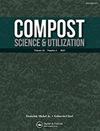鸡窝堆肥中噬菌体替代病原病毒热失活的比较与模拟
IF 0.9
4区 农林科学
Q3 ECOLOGY
引用次数: 1
摘要
摘要本研究的目的是比较和模拟噬菌体作为致病病毒(如禽流感病毒)替代物在鸡粪堆肥中的热灭活。将三种噬菌体[ø6、MS2和Felix O1(FO)]分别接种到具有不同水分含量(MC)的老化鸡粪堆肥中,然后暴露于75和85 °C,最多3 h.在所有测试条件下,噬菌体ø6在出现时间内都无法检测到。3之后 h 75℃的热处理 °C时,在含有20%、30%和40%MC的堆肥中,MS2的种群减少量分别为5.83、6.08和8.32 log菌斑形成单位(PFU g−1),而FO分别为4.87、5.40和5.75 log PFU g–1。暴露于85 °C时,含20%、30%和40%MC的堆肥中MS2的种群减少量分别为6.07、7.93和8.03 log PFU g−1,而FO的种群减少率分别为6.29、6.20和7.59 log PFU g-1。MS2和FO两种噬菌体从堆肥中的回收率都较高,并且MS2噬菌体的耐热性与已报道的禽流感病毒的耐热性相比FO噬菌体具有相当的耐热性。此外,还建立了所提出的非线性三相模型来描述暴露于物理热处理的噬菌体在不同阶段的存活情况。考虑到病毒可能在堆肥堆的一些冷点存活,本研究为肥料行业验证其加热过程的有效性提供了科学证据,以灭活鸡粪堆肥中的禽流感病毒。本文章由计算机程序翻译,如有差异,请以英文原文为准。
Comparing and Modeling the Thermal Inactivation of Bacteriophages as Pathogenic Viruses Surrogates in Chicken Litter Compost
Abstract The aim of this study was to compare and model the thermal inactivation of bacteriophages as surrogates for pathogenic viruses, such as avian influenza virus, in chicken litter compost. Three bacteriophages [ø6, MS2, and Felix O1 (FO)] were inoculated separately into aged chicken litter compost with various moisture contents (MCs), and then exposed to 75 and 85 °C for up to 3 h. The bacteriophage ø6 was undetectable during come-up time at all tested conditions. After 3 h heat treatment at 75 °C, population reductions of MS2 in the compost with 20, 30, and 40% MCs were 5.83, 6.08, and 8.32 log plaque forming units (PFU g−1), respectively, as compared with 4.87, 5.40, and 5.75 log PFU g−1 for FO, respectively. When exposed to 85 °C, population reductions of MS2 in the compost with 20, 30, and 40% MCs were 6.07, 7.93, and 8.03 log PFU g−1, respectively, as compared with 6.29, 6.20, and 7.59 log PFU g−1 for FO, respectively. Both bacteriophages MS2 and FO had higher recovery rates from compost, and bacteriophage MS2 had a comparable thermal resistance with the reported resistance of avian influenza virus than bacteriophage FO. Additionally, the proposed non-linear three-phase model was developed to describe the survival of bacteriophages exposed to the physical-heat treatment into different stages. Considering that virus may survive in some cold spots of compost piles, this study provides scientific evidence for the fertilizer industry to validate the effectiveness of their heating process in order to inactivate avian influenza virus in chicken litter compost.
求助全文
通过发布文献求助,成功后即可免费获取论文全文。
去求助
来源期刊

Compost Science & Utilization
农林科学-生态学
CiteScore
4.10
自引率
0.00%
发文量
0
审稿时长
>36 weeks
期刊介绍:
4 issues per year
Compost Science & Utilization is currently abstracted/indexed in: CABI Agriculture & Environment Abstracts, CSA Biotechnology and Environmental Engineering Abstracts, EBSCOhost Abstracts, Elsevier Compendex and GEOBASE Abstracts, PubMed, ProQuest Science Abstracts, and Thomson Reuters Biological Abstracts and Science Citation Index
 求助内容:
求助内容: 应助结果提醒方式:
应助结果提醒方式:


